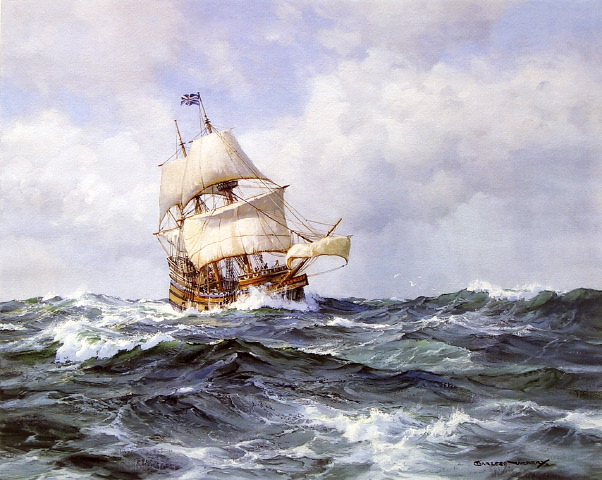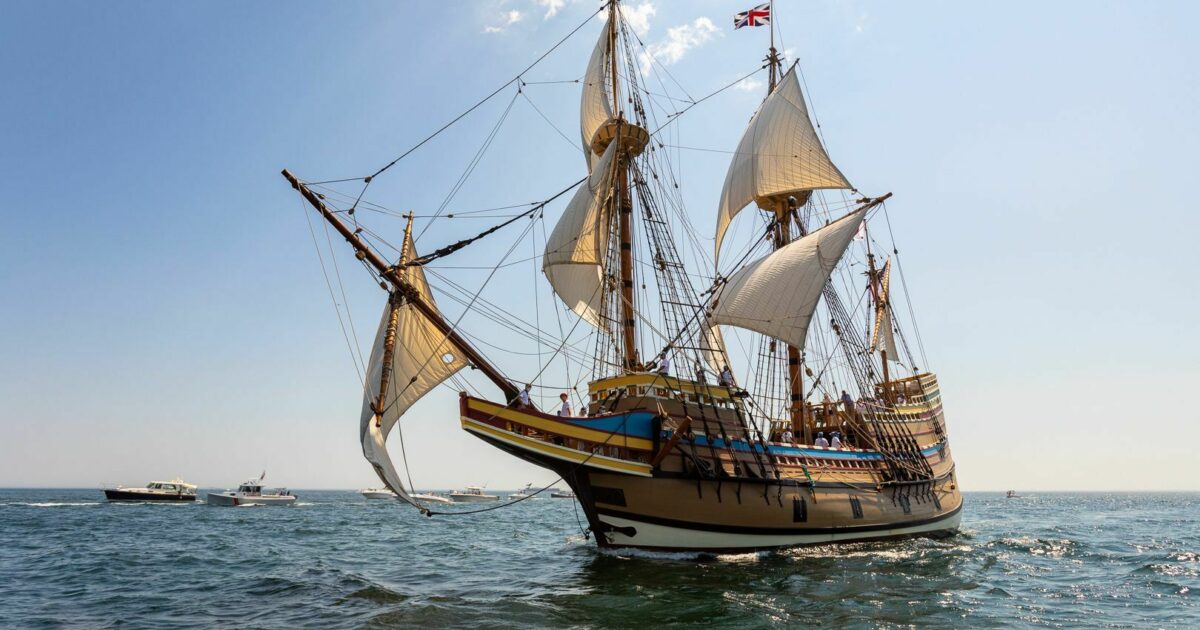The Mayflower’s Journey
Table of Contents
Few can talk about American Thanksgiving without some basic knowledge of the Mayflower. This important ship pretty much was a last refuge to eccentric Pilgrims who needed sanctuary from a mad and crazy Europe. There pretty much weren’t many options left for the Pilgrims in Europe and an escape to the New World was a better bet than Europe.
But what do we really know about this ship – besides the perilous journey across the Atlantic and the early form of government formed by the Pilgrims (in honor of the ship’s name).
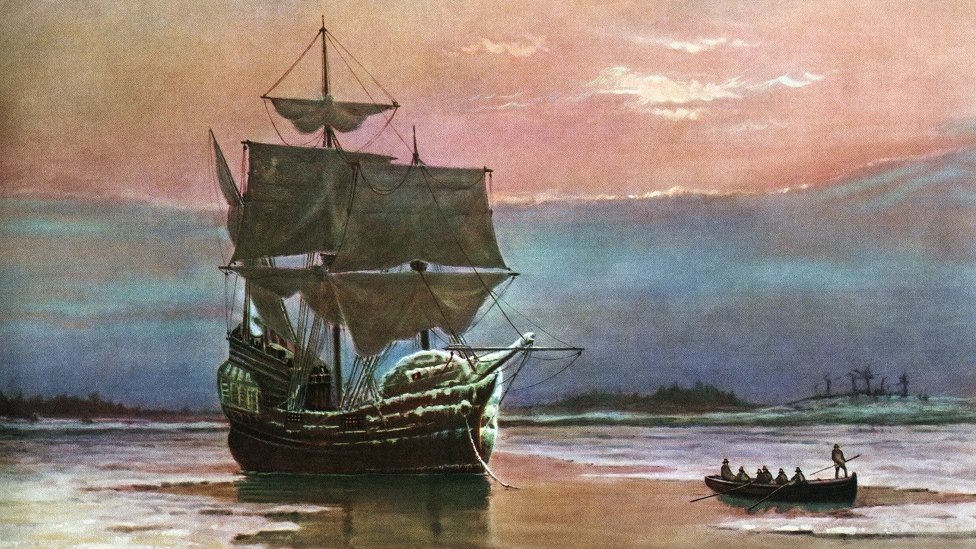
The Mayflower: Ship History
There were 26 vessels bearing the name the Mayflower in the Port Books of England during the reign of James I (1603–1625); it is not known why the name was so popular. The identity of Captain Jones’s Mayflower is based on records from her home port, her tonnage (est. 180–200 tons), and the master’s name in 1620 in order to avoid confusion with the many other Mayflower ships.
It is not known when and where Mayflower was built, although late records designate her as “of London”. She was designated in the Port Books of 1609–11 as “of Harwich” in the county of Essex, coincidentally the birthplace of the Mayflower master Christopher Jones about 1570.
Records dating from August 1609 note Christopher Jones as master and part owner of Mayflower when his ship was chartered for a voyage from London to Trondheim in Norway and back to London. The ship lost an anchor on her return due to bad weather, and she made short delivery of her cargo of herring. Litigation resulted, and this was still proceeding in 1612.
According to records, the ship was twice on the Thames at London in 1613, once in July and again in October and November, and in 1616 she was on the Thames carrying a cargo of wine, which suggests that the ship had recently been on a voyage to France, Spain, Portugal, the Canaries, or some other wine-producing land. Jones sailed Mayflower cross-Channel, taking English woolens to France and bringing French wine back to London. He also transported hats, hemp, Spanish salt, hops, and vinegar to Norway, and he may have taken Mayflower whaling in the North Atlantic off Spitsbergen or sailed to Mediterranean ports.
After 1616, there is no further record which specifically relates to Jones’s Mayflower until 1624. This is unusual for a ship trading to London, as it would not usually disappear from the records for such a long time. No Admiralty court document can be found relating to the pilgrim fathers’ voyage of 1620, although this might be due to the unusual way in which the transfer of the pilgrims was arranged from Leyden to New England, or some of the records of the period might have been lost.
Jones was one of the owners of the ship by 1620, along with Christopher Nichols, Robert Child, and Thomas Short. It was from Child and Jones that Thomas Weston chartered her in the summer of 1620 to undertake the Pilgrim voyage. Weston had a significant role in Mayflower voyage due to his membership in the Company of Merchant Adventurers of London, and he eventually traveled to the Plymouth Colony himself.
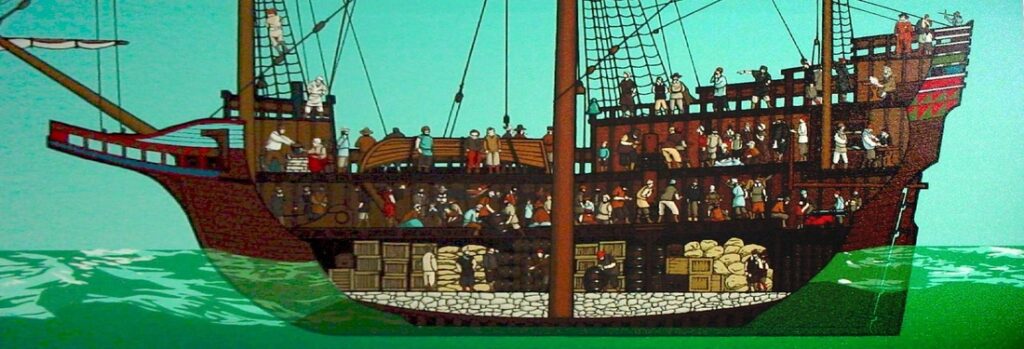
The Mayflower: Design and Layout
The Mayflower was square-rigged with a beakhead bow and high, castle-like structures fore and aft that protected the crew and the main deck from the elements: designs that were typical of English merchant ships of the early 17th century.
Her stern carried a 30-foot high, square aft-castle which made the ship difficult to sail close to the wind and not well suited against the North Atlantic’s prevailing westerlies, especially in the fall and winter of 1620; the voyage from England to America took more than two months as a result. Mayflower’s return trip to London in April–May 1621 took less than half that time, with the same strong winds now blowing in the direction of the voyage.
The Mayflower’s exact dimensions are not known, but she probably measured about 100 feet (30 m) from the beak of her prow to the tip of her stern superstructure, about 25 feet (7.6 m) at her widest point, and the bottom of her keel about 12 feet (3.6 m) below the waterline. William Bradford estimated that she had a cargo capacity of 180 tons, and surviving records indicate that she could carry 180 casks holding hundreds of gallons each: 37 The general layout of the ship was as follows:
Three masts: mizzen (aft), main (midship), and fore, and also a spritsail in the bow area
Three primary levels: main deck, gun deck, and cargo hold
Aft on the main deck in the stern was the cabin for Master Christopher Jones, measuring about ten by seven feet (3 m × 2.1 m). Forward of that was the steerage room, which probably housed berths for the ship’s officers and contained the ship’s compass and whipstaff (tiller extension) for sailing control.
Forward of the steerage room was the capstan, a vertical axle used to pull in ropes or cables. Far forward on the main deck, just aft of the bow, was the forecastle space where the ship’s cook prepared meals for the crew; it may also have been where the sailors slept.
The poop deck was located on the ship’s highest level above the stern on the aft castle and above Master Jones’ cabin. On this deck stood the poop house, which was ordinarily a chart room or a cabin for the master’s mates on most merchant ships, but it might have been used by the passengers on Mayflower, either for sleeping or cargo.
The gun deck was where the passengers resided during the voyage, in a space measuring about 50 by 25 feet (15.2 m × 7.6 m) with a five-foot (1.5 m) ceiling. It was a dangerous place if there was conflict, as it had gun ports from which cannon would be run out to fire on the enemy. The gun room was in the stern area of the deck, to which passengers had no access because it was the storage space for gunpowder and ammunition.
The gun room might also house a pair of stern chasers, small cannon used to fire from the ship’s stern. Forward on the gun deck in the bow area was a windlass, similar in function to the steerage capstan, which was used to raise and lower the ship’s main anchor. There were no stairs for the passengers on the gun deck to go up through the gratings to the main deck, which they could reach only by climbing a wooden or rope ladder.
Below the gun deck was the cargo hold where the passengers kept most of their food stores and other supplies, including most of their clothing and bedding. It stored the passengers’ personal weapons and military equipment, such as armor, muskets, gunpowder and shot, swords, and bandoliers. It also stored all the tools that the Pilgrims would need, as well as all the equipment and utensils needed to prepare meals in the New World.
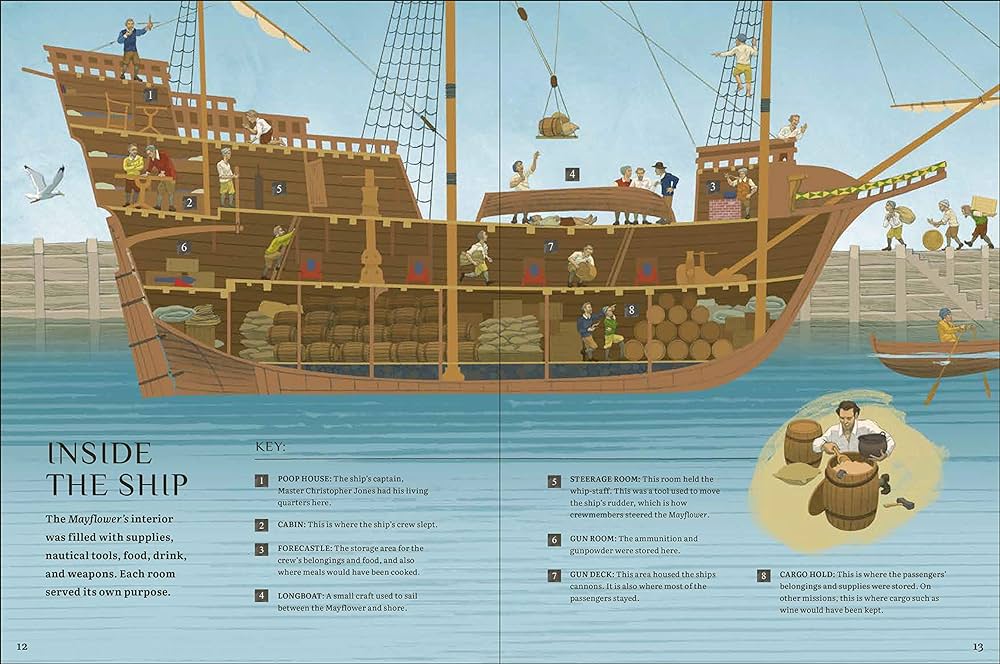
Some Pilgrims loaded trade goods on board, including Isaac Allerton, William Mullins, and possibly others; these also most likely were stored in the cargo hold. There was no privy on Mayflower; passengers and crew had to fend for themselves in that regard. Gun deck passengers most likely used a bucket as a chamber pot, fixed to the deck or bulkhead to keep it from being jostled at sea.
Mayflower was heavily armed; her largest gun was a minion cannon which was brass, weighed about 1,200 pounds (545 kg), and could shoot a 3.5 pound (1.6 kg) cannonball almost a mile (1,600 m). She also had a saker cannon of about 800 pounds (360 kg), and two base cannons that weighed about 200 pounds (90 kg) and shot a 3 to 5 ounce ball (85–140 g).
She carried at least ten pieces of ordnance on the port and starboard sides of her gun deck: seven cannons for long-range purposes, and three smaller guns often fired from the stern at close quarters that were filled with musket balls. Ship’s Master Jones unloaded four of the pieces to help fortify Plymouth Colony.
